Table of Contents
The Angolan flag, also known as the flag of Angola, holds a significant place in the nation’s history and culture, representing the Angolan identity and heritage. With its distinctive colors and meaningful symbolism, the flag stands as a powerful symbol of unity and pride. In this article, we will delve into the intriguing aspects of the Angola flag, exploring its design, historical background, and the symbolism behind its elements.
The Angola flag consists of two horizontal bands of red and black, with a centered emblem featuring a yellow half gear wheel crossed by a machete and crowned with a yellow star. The flag’s colors and emblem hold deep symbolic meaning for the Angolan people and reflect the nation’s values, aspirations, and historical significance.
Angola Flag: Colors and Symbolism
- The flag of Angola features two horizontal bands of red and black.
- Positioned in the center of the flag is an emblem consisting of a yellow half gear wheel crossed by a machete and crowned with a yellow star.
- The red band represents the blood shed by Angolans in their struggle for independence and freedom.
- The black band symbolizes the continent of Africa and the people of Angola.
- The yellow color of the emblem represents the country’s wealth and resources, as well as the sun shining over Angola’s bright future.
- The half gear wheel symbolizes industrial workers and the country’s industrial development.
- The machete represents the peasantry and agricultural production, as well as the armed struggle for independence.
- The yellow star represents international solidarity and the hope for a brighter future.
- Together, these elements create a flag that embodies the spirit and resilience of the Angolan people, as well as their aspirations for a prosperous and united nation.
Flag of Angola
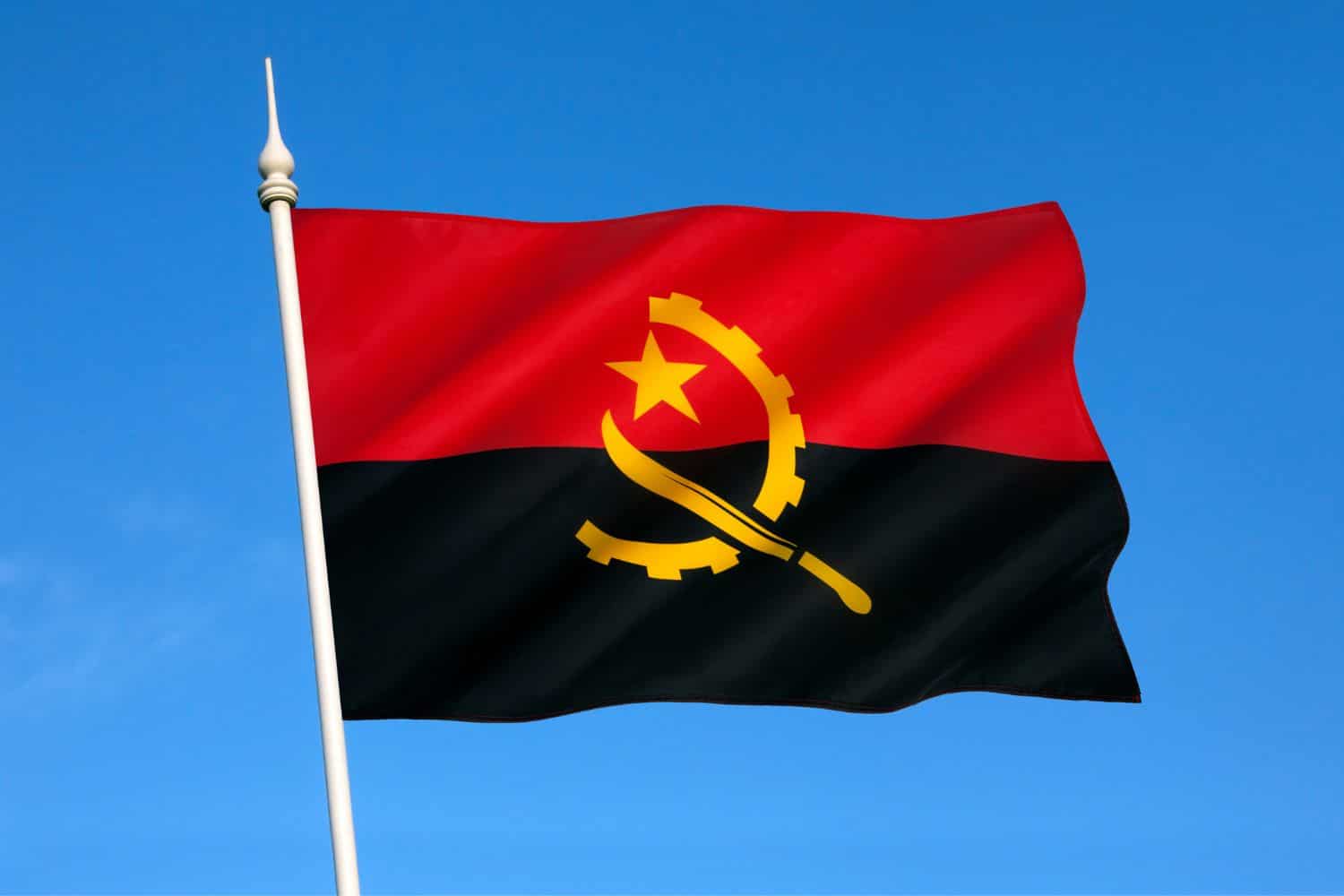
The Angolan flag features two horizontal bands: red and black from top to bottom. In the center of the flag, there’s an emblem consisting of a yellow half gear wheel crossed by a machete and crowned with a yellow star.
The red band at the top symbolizes the blood shed by Angolans in their quest for independence and freedom. It represents the sacrifices made and the determination of the Angolan people to achieve self-determination.
The black band at the bottom signifies the African continent and the people of Angola. It reflects the unity and solidarity among African nations and embodies the shared struggles and aspirations for a better future.
The emblem in the center of the flag holds significant symbolism. The yellow color represents the country’s wealth and resources, as well as the bright future ahead. The half gear wheel symbolizes industrial workers and the nation’s industrial development, highlighting Angola’s progress and economic potential. The machete represents agricultural production and the peasantry, as well as the armed struggle for liberation. The yellow star represents international solidarity and the hope for a prosperous future, shining brightly over Angola.
National Flag Etiquette and Protocol
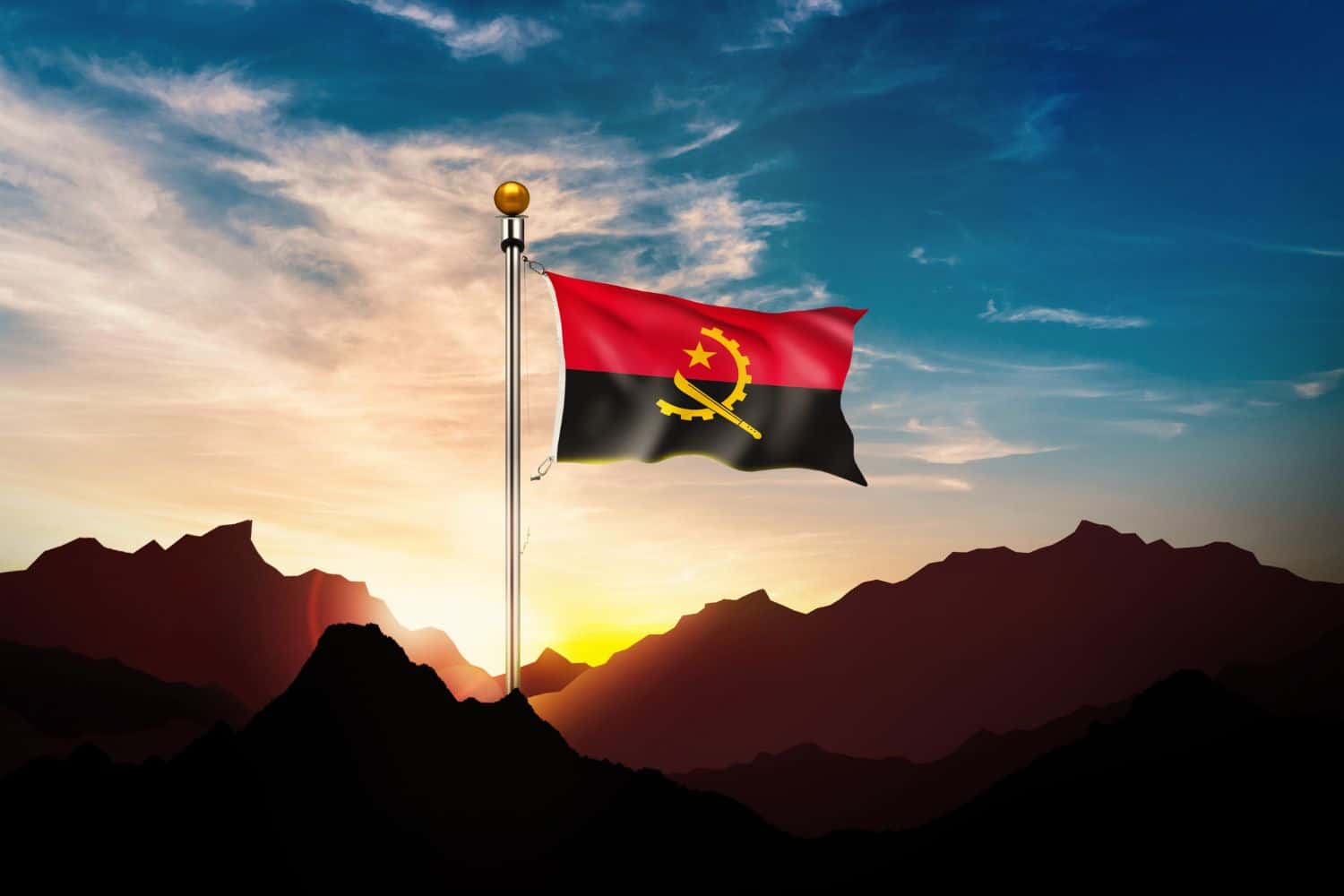
Respecting the proper usage and display of the Angolan flag is essential to honor the nation’s heritage and identity. Adhering to flag etiquette ensures that the flag is treated with the reverence it deserves, especially during national events and ceremonies.
- Proper Handling: Handle the flag with care and respect, avoiding letting it touch the ground or floor. Hold it upright without dragging to maintain its dignity.
- Hoisting and Lowering: Hoist the flag briskly and lower it ceremoniously, following specific guidelines or occasions. Typically, the flag is raised at sunrise and lowered at sunset, marking the beginning and end of each day with honor.
- Displaying the Flag: When displaying the flag vertically, ensure the red band is at the top, followed by the black band. Display the flag freely without entanglement or obstruction to show respect for its symbolism.
- Half-Staff: Lowering the flag to half-staff is a sign of mourning or respect. This gesture is observed on designated days of remembrance or to honor the passing of significant figures in the nation’s history.
- Flag Retirement: When a flag becomes damaged or worn out, it should be retired in a dignified manner. Follow appropriate guidelines and local regulations for retiring the flag, which may include burning it in a respectful ceremony.
- Flag Size and Placement: Display the flag in proportion to the flagpole or display area, following local guidelines or regulations. Ensure proper placement to show respect for the flag’s significance and symbolism.
- Respectful Disposal: If a flag cannot be retired through burning, dispose of it respectfully, considering burial or handing it over to authorized organizations for proper disposal. This ensures that the flag is treated with the dignity it deserves even in retirement.
Interesting Facts and Trivia
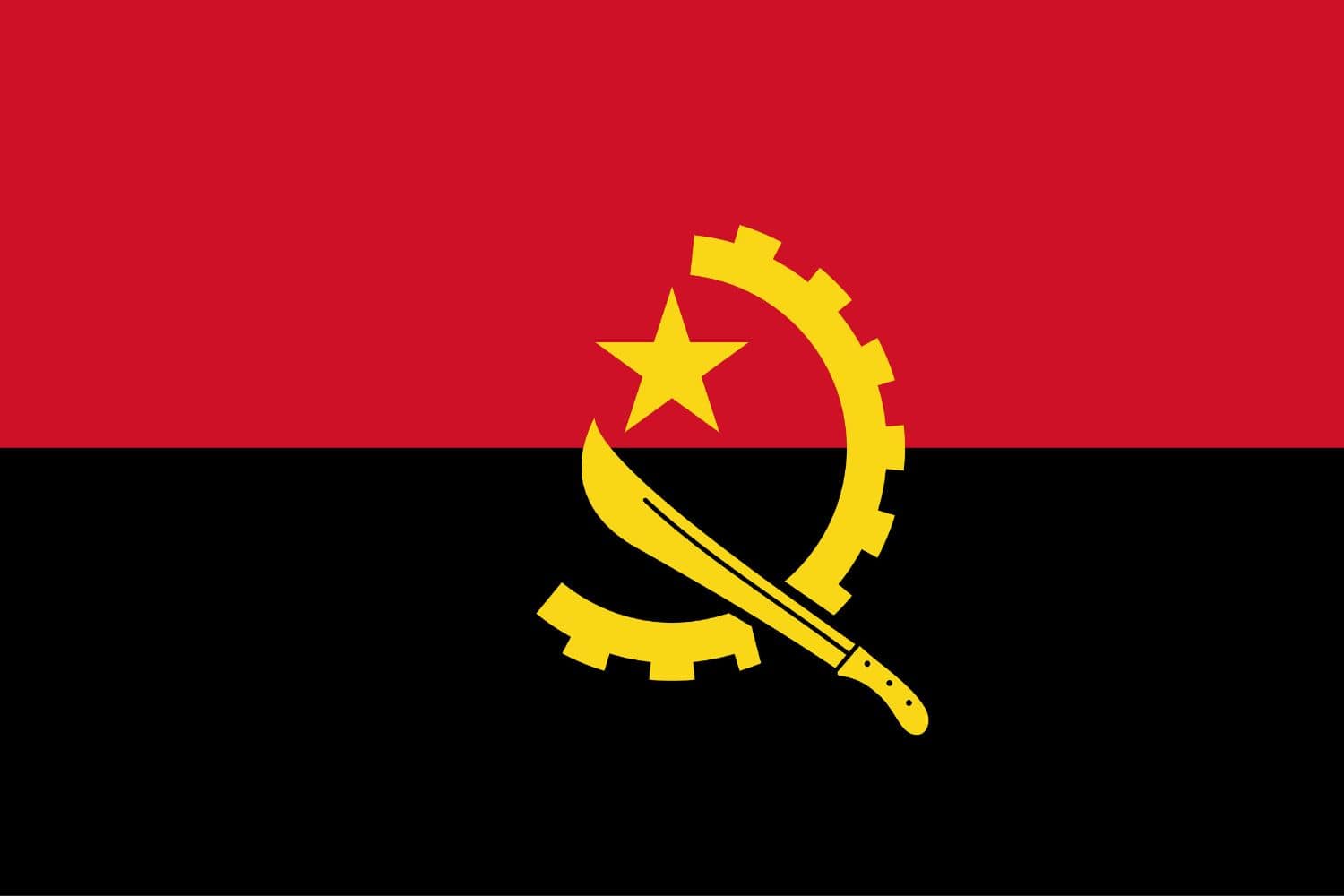
Embark on a journey of intriguing facts and lesser-known trivia about the flag of Angola. Discover unique elements within the flag’s design that carry hidden symbolism. Uncover stories of notable incidents or events involving the flag that have shaped the nation’s history and identity.
Rich Tapestry of History
- 1920s: The modern flag was adopted during Angola’s struggle for independence from Portuguese colonial rule, symbolizing the nation’s quest for freedom and unity.
- 1975: Following independence, Angola retained the same flag, reflecting the aspirations of its people and marking a new era in the country’s history.
- Late 20th Century: Various changes occurred in the flag’s design, reflecting Angola’s evolving political landscape and aspirations for progress and unity among its diverse population.
- Present Day: The current flag design, with its distinctive emblem and colors, represents Angola’s rich heritage, unity, and determination for a prosperous future.
These historical vignettes underscore pivotal moments in Angola’s flag history, showcasing its significance in shaping the nation’s identity and embodying its struggles and triumphs over the years.
Flag-Related Symbols and Emblems
The flag is just one aspect of Angola’s national identity. Explore additional symbols and emblems closely linked with Angola, understanding their cultural and historical significance and their relationship with the flag. Delve into their roots to gain a deeper appreciation of Angola’s rich heritage. Angola’s tourist attractions offer a wealth of historical insights and intriguing facts waiting to be explored.
Symbolisms of the Angolan Flag
The flag of Angola carries profound symbolic elements that encapsulate the nation’s history, values, and aspirations. Here are the symbolisms of the Angolan flag presented in itemized form:
- Red Color: Signifies the blood shed by Angolans in their struggle for independence and sovereignty, embodying courage, sacrifice, and resilience.
- Black Color: Represents the rich cultural heritage of Angola and the determination of its people to overcome past oppression and injustice.
- Yellow Machete: Symbolizes the agricultural wealth of Angola and the importance of labor and production in the nation’s development and prosperity.
- Cogwheel: Represents industry and progress, reflecting Angola’s commitment to economic growth and technological advancement.
- Star: Symbolizes unity and internationalism, as well as the guiding light of freedom and independence for all Angolans.
- Historical Legacy: The flag embodies Angola’s historical journey, including its fight against colonialism, struggle for independence, and ongoing quest for social justice and equality.
- National Identity: Serving as a powerful emblem of unity, the flag fosters a sense of national pride and belonging among Angolans, regardless of their diverse backgrounds.
- National Aspirations: Through its design and symbolism, the flag articulates Angola’s aspirations for peace, prosperity, and progress, inspiring its citizens to work towards a brighter future.
These symbolisms in the flag are integral to Angola’s collective identity and serve as a source of inspiration for its people as they strive for a better tomorrow.
Flags of Similar Countries or Regions
Analyzing the flags of neighboring countries or regions can unveil fascinating connections. Examine and compare the flags, delving into similarities in design, colors, or symbolism. Reveal historical and cultural ties between flags, shedding light on shared influences or unique identities. Exploring Angola is a viable option with assured safety measures.
Angolan Flag vs Namibian Flag
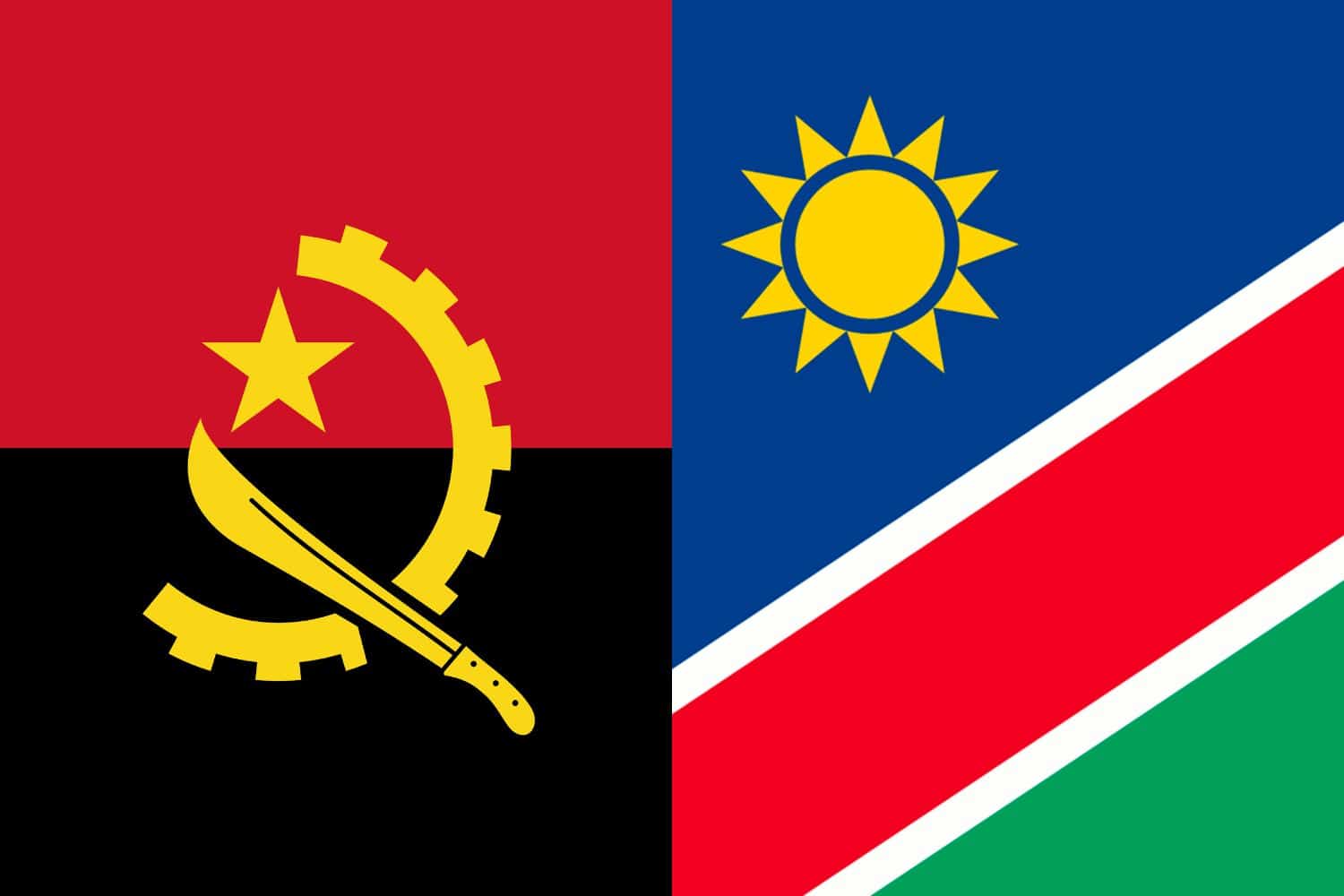
Similarity: Both flags prominently feature the color red, symbolizing valor and sacrifice.
Difference: The Angolan flag consists of two horizontal bands, red on top and black on the bottom, with a centered emblem featuring a yellow half gear wheel and machete crossed by a star. In contrast, the Namibian flag features a blue triangle with a golden sun and stripes of red, white, and green.
Angolan Flag vs Democratic Republic of the Congo Flag
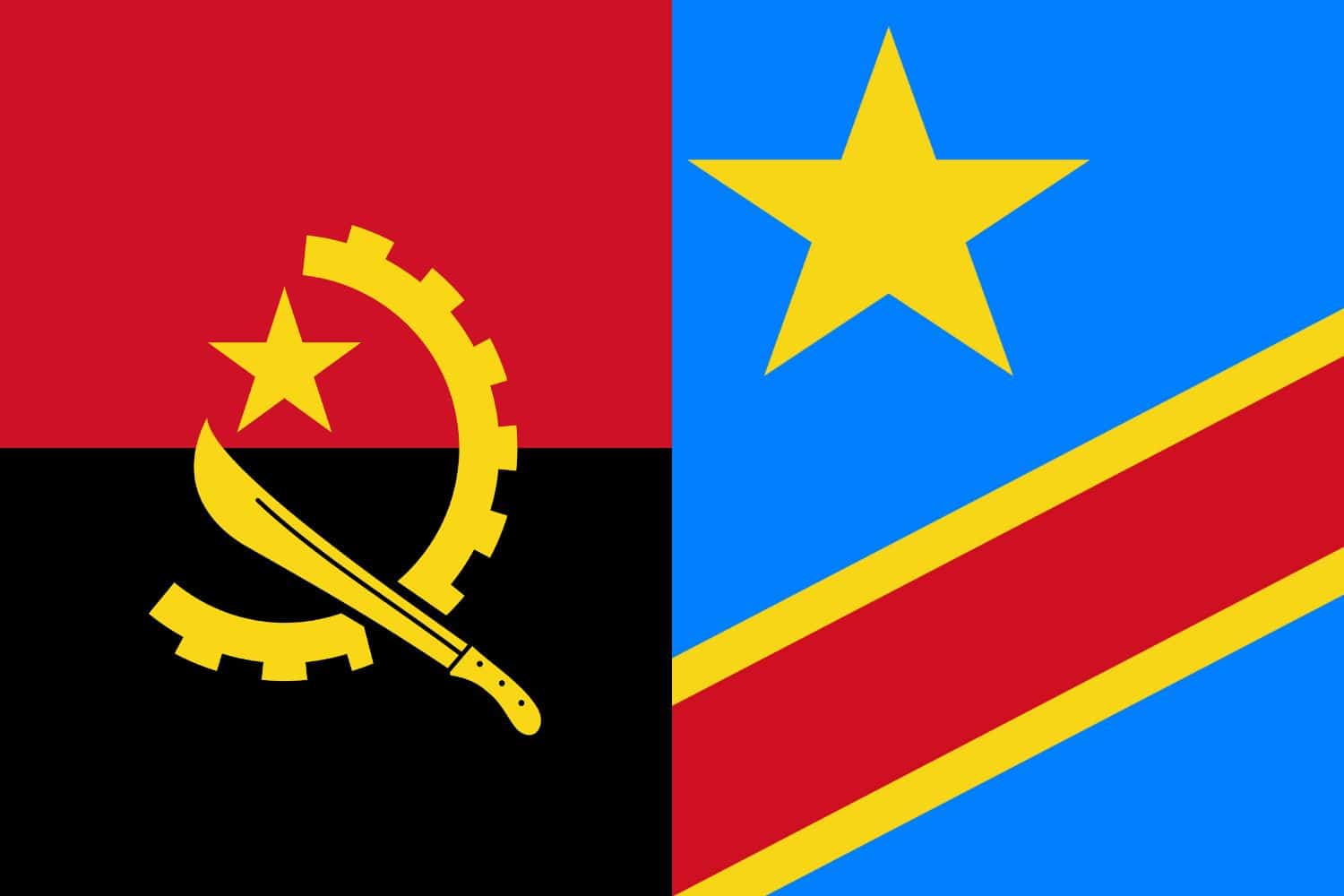
Similarity: Both flags incorporate the colors red, yellow, and blue.
Difference: The Angolan flag features a centered emblem with a yellow half gear wheel and machete crossed by a star on a red and black background. Conversely, the Democratic Republic of the Congo flag consists of a sky blue field with a yellow star in the upper left corner and a red diagonal stripe with a yellow fimbriation running from the lower hoist side to the upper fly side.
Angolan Flag vs Zambia Flag
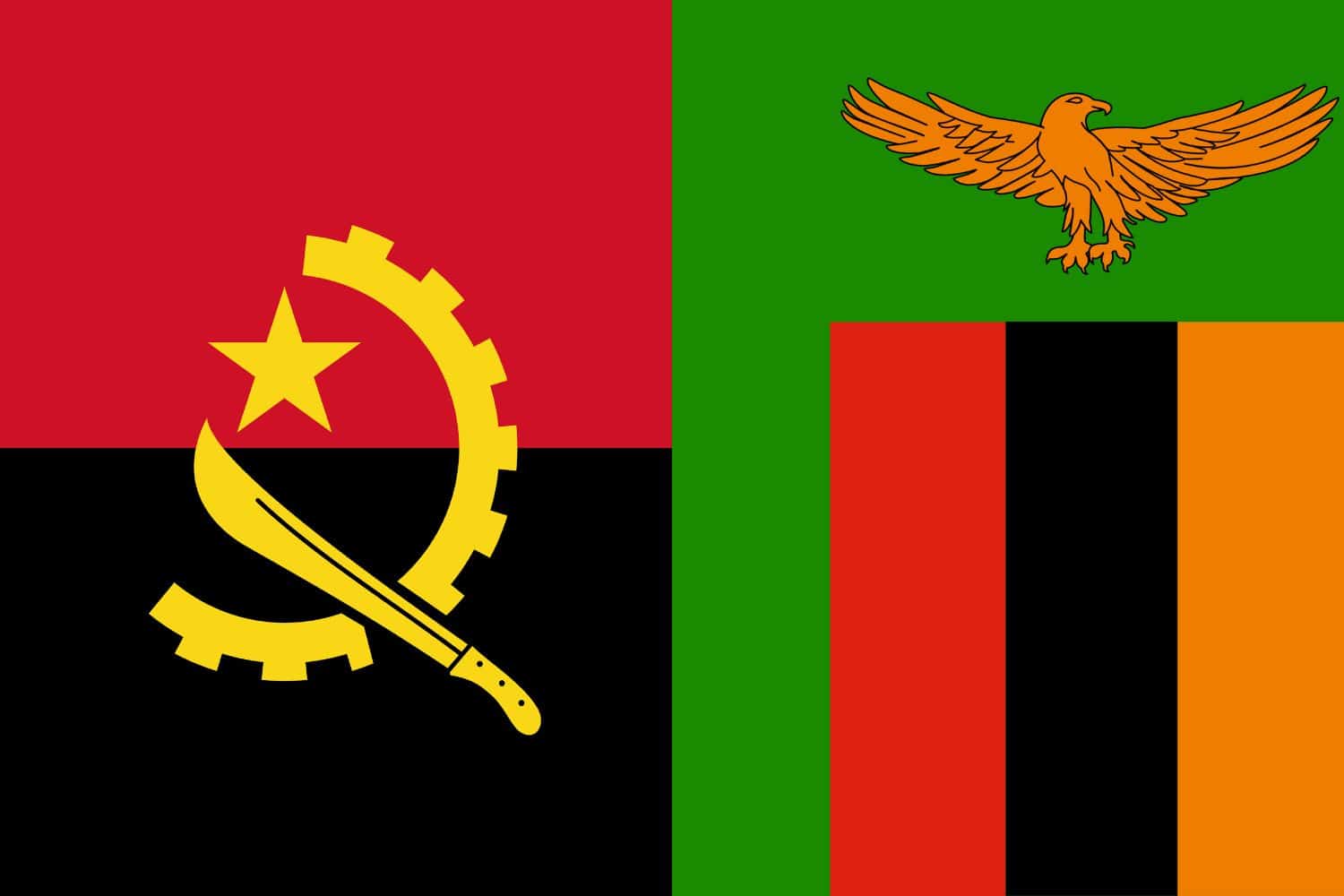
Similarity: Both flags feature a combination of green, red, and black.
Difference: The Angolan flag consists of two horizontal bands, red on top and black on the bottom, with a centered emblem featuring a yellow half gear wheel and machete crossed by a star. On the other hand, the Zambian flag has a green field with an orange-colored eagle flying over a rectangular block of three vertical stripes: black, orange, and red.
Angolan Flag vs Republic of the Congo Flag
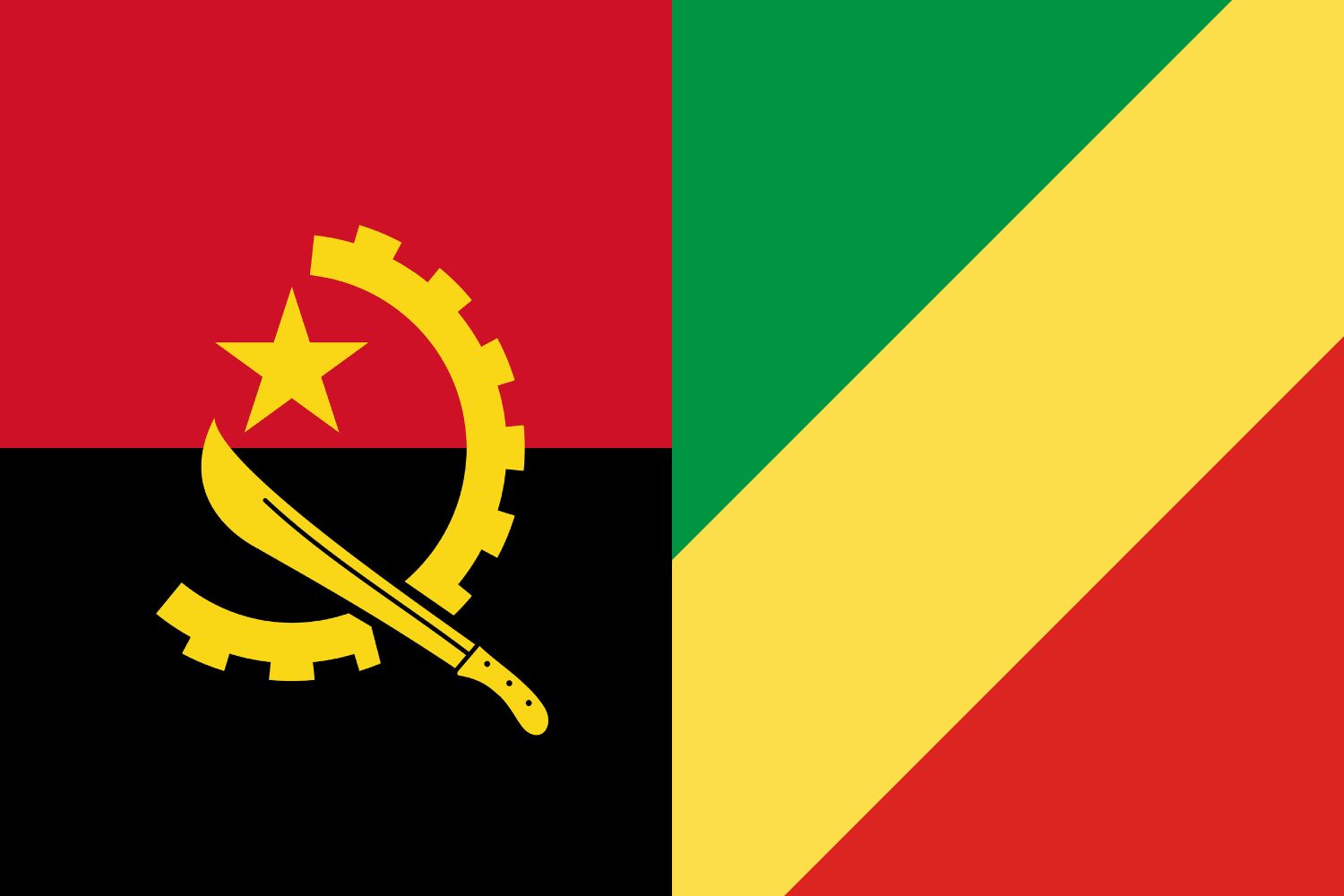
Similarity: Both flags incorporate the colors red, yellow, and green.
Difference: The Angolan flag features a centered emblem with a yellow half gear wheel and machete crossed by a star on a red and black background. Conversely, the Republic of the Congo flag consists of a diagonal tricolor of green, yellow, and red with a yellow five-pointed star in the upper left corner.
Angolan Flag vs Brazil Flag
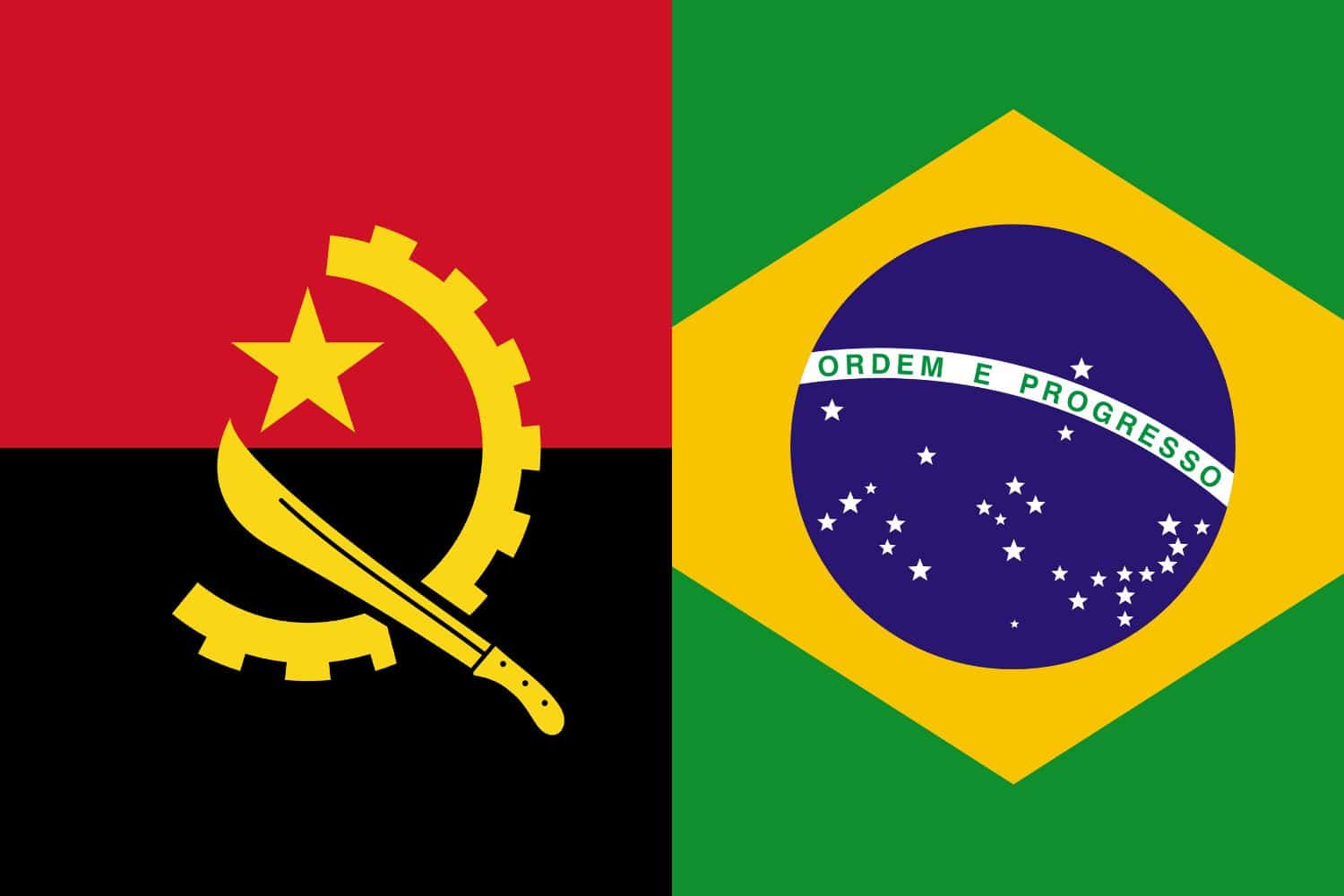
Similarity: Both flags feature a prominent green and yellow color scheme.
Difference: The Angolan flag consists of two horizontal bands, red on top and black on the bottom, with a centered emblem featuring a yellow half gear wheel and machete crossed by a star. In contrast, the Brazilian flag showcases a green field with a yellow diamond containing a blue globe with white equatorial bands and a white banner with the national motto inscribed in green.
Angolan Flag vs Portugal Flag
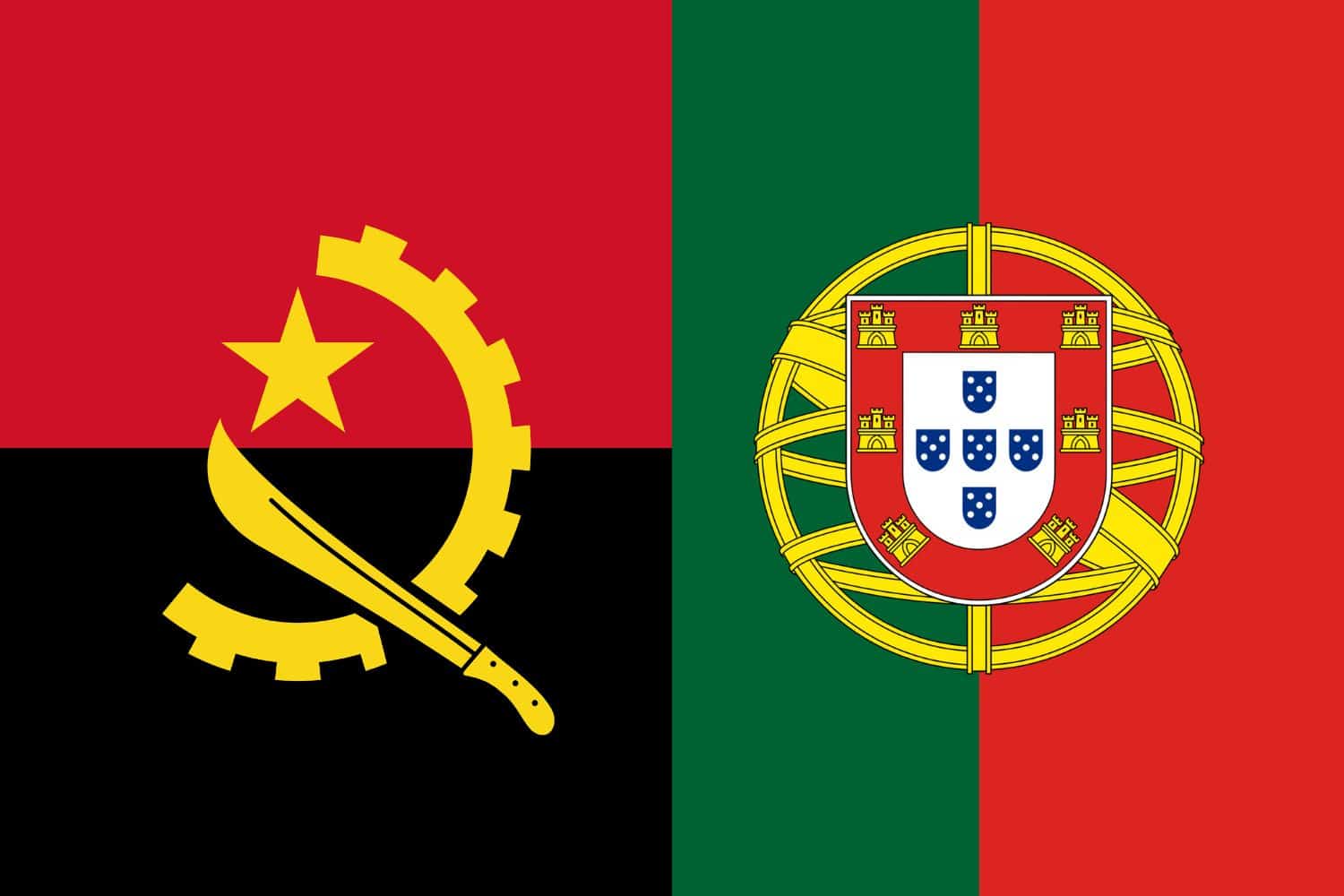
Similarity: Both flags incorporate the colors red, yellow, and green.
Difference: The Angolan flag features a centered emblem with a yellow half gear wheel and machete crossed by a star on a red and black background. Conversely, the Portuguese flag consists of two vertical bands, green on the hoist side and red on the fly side, with the national coat of arms in the center on a field of yellow.
Frequently Asked Questions (FAQs)
Explore answers to common questions concerning the Angola flag picture. Delve into its historical background and uncover the symbolism embedded in its elements. Discover succinct and informative responses addressing inquiries frequently raised by those intrigued by Angola’s flag.
What are the colors of the Angola flag?
The Angola flag consists of two primary colors: red and black, with a yellow emblem in the center.
What does the red color represent on the Angola flag?
The red color on the Angola flag symbolizes the bloodshed and sacrifices made during Angola’s struggle for independence.
What does the black color represent on the Angola flag?
The black color on the Angola flag represents the continent of Africa, acknowledging Angola’s African heritage and identity.
What is the significance of the yellow emblem on the Angola flag?
The yellow emblem, a machete and a gear wheel crossed by a cogwheel, represents the country’s agricultural and industrial sectors, reflecting its aspirations for progress and development.
How many horizontal stripes does the Angola flag have, and what do they represent?
The Angola flag features two horizontal stripes: a red one on the top and a black one on the bottom. These stripes symbolize the bloodshed and the continent of Africa, respectively.
What is the history behind the design of the Angola flag?
The current design of the Angola flag was adopted on November 11, 1975, when Angola gained independence from Portugal. It replaced the flag of the Popular Movement for the Liberation of Angola (MPLA), which was used during the country’s fight for independence.
Does the Angola flag have any religious significance?
No, the Angola flag does not have any religious symbols or connotations. It primarily represents the nation’s history, struggle for independence, and aspirations for a better future.
Are there any variations of the Angola flag used for specific purposes?
Yes, there are variations of the Angola flag used for different purposes. For example, there is a version with the national emblem in the center used for official governmental purposes, and another version without the emblem used for civilian purposes.
